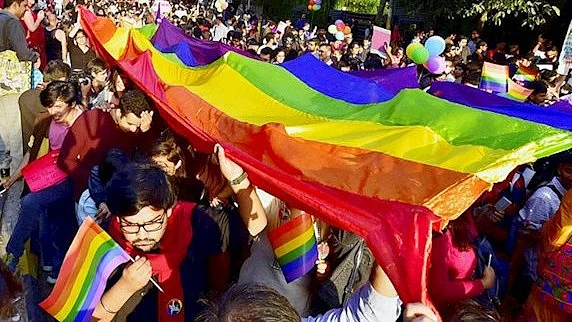Living in a country which hoists up a primitive law such as Section 377 that criminalises homosexuality, is a matter of concern for any of its citizens, irrespective of their sexual orientation.
For members of the LGBTQ community however, it’s a step above, because the issue is not just limited to the problem of regression. It affects their basic safety in a country where they are considered criminals for adhering to their natural instinct.
But times are changing.
The need to create ‘safe spaces’ for members of the Indian LGBTQ community across the online and offline world, has become paramount and fiery-spirited individuals and organisations have made it their mission to achieve the same. Be it through giving them a platform to share their stories and experiences, or by providing them with a housing space that bodes no discrimination, the aim is to help them feel safe, protected, and free from any undue judgement or bias.
To understand the progress and need for these safe spaces for the LGBTQ community, a group of panellists, hailing from different Queer networks, assembled for an event at the Godrej India Culture Lab on Friday to discuss the myriad struggles, epiphanies, challenges and victories that mark the journey that pushes towards it.
Creating Safe Spaces Online
While India may be more accepting and supportive of its LGBTQ community now, it still has a long way to go before we can make them feel like they are in a safe environment.
That environment, today, has largely shifted base to the digital world. We live, eat and breathe social media, so using that as a platform to encourage members of the community to speak up, share their experience and receive acceptance, in any form, is a well-placed strategic move.
Social media has helped bring about awareness and empower the queer community.Sakshi Juneja, Founder of Gaysi, a popular online Queer blog.
Speaking about the blog which has over a thousand LGBTQ members sharing their stories daily and connecting with one another, Juneja says that the main reason she started Gaysi in 2008 was to act upon her need to just hang around with other queer individuals. It gave them a common ground and platform to feel secure enough to share their individual experiences, and be assured that they would never be condemned for it.
Digital Safe Spaces to Discrimination-Free Housing
Sachin Jain, the founder of GHAR (Gay Housing Assistance Resource), which literally translates to ‘home’, spoke about how he, too, used the online space to provide a safe housing situation to members of the community.
As a gay man who had just come out, I found there were enormous difficulties that I faced in looking for a place when I moved out of home in 1998. I met with a lot of hostility from my neighbours, flatmates and landlords.Sachin Jain, founder of GHAR
Although Bombay was known as a “Mecca of Gay Liberation” for members of the community, especially for those hailing from small towns, they all found that once they came here and started renting, they were forced to dive back into the closet.
The idea behind GHAR is for Queer people to find one another, in order to create safe households. It helps you create an island of acceptance and safety for yourself.Sachin Jain
After facing almost a decade worth of challenges in expanding this the organisation, he decided to use the infinite reach of Facebook in 2012, and today, it has helped almost 4,300 members hailing from 18 different cities. It also boasts of about 1,000 postings every year.
Challenges of a Digital 'Safe' Space
While the digital space is the perfect platform to share messages of support and empowerment, and does work as a great network for members of the community to connect with one another, it also runs the equal risk of being trolled in terms of homophobic and hateful comments.
Being an open platform, those monitoring these safe digital spaces must take extra caution to monitor any kind of hate-speech which may be directed towards the LGBTQ community, the panellists said in unison.
Koninika Roy, a core member of Yaariyan, the youth support group of the Humsafar Trust, the oldest LGBTQ organisation in India, also spoke about the challenges of monitoring the comments on a very active online platform that hosts about 7,500 members.
At times like this, you have to just rely on the fact that if anyone does post a homophobic comment against the community, the majority of the community will come together and ensure that the person doesn’t get away with it.Koninika Roy, administrator of Yaariyan
The Problem of Intersectionality
One of the most important challenges faced by those attempting to create ‘safe spaces’ for members of the LGBTQ community is the problem of intersectionality.
Even within the community, matters of clashes in terms of caste, religion and other social factors are not overlooked, with the privileged classes being open to gender fluidity, but not to the religious and economic barriers that blatantly make up the Indian society. The reaction that a gay man hailing from an upper-middle class family and his Dalit counterpart, will, in all probability, be different, even from other members of the LGBTQ community.
In terms of the digital space, however, the matter of intersectionality is being addressed in various ways, considering its virtual, open and far-reaching effects. It helps social activists and others, both within and outside the community, to help reduce the discrimination gap between different sections of society.
However, it would be wrong to say that social barriers outside sexuality were not in play, even within the LGBTQ community. And that’s why it’s important to address and change it.
As writer Shiri Eisner said, one must understand that “different kinds of oppression are interlinked, and that one can't liberate only one group without liberating the others.”
After all, safe spaces are only created in light of the freedom and liberation of all groups. It can’t afford to be selective.
